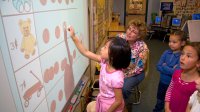What a Kindergarten Teacher Learned From Virtual School
Teachers and students can benefit from continuing to apply techniques that were necessary during virtual instruction—with some tweaks.
Your content has been saved!
Go to My Saved Content.The 2020–21 school year was unlike any I have experienced in my more than 20 years of teaching. I taught my newest crop of kindergarteners virtually from September through mid-March, and then in a hybrid model through the end of the school year in mid-June (half in the classroom, half at home, all still through Zoom).
Most schools will be returning to the traditional teaching and learning setting for the upcoming school year. I would like to think, however, that the new skills we as teachers worked so hard to learn while we were virtual do not all have to be laid to rest. They just need to be adapted—and may make our teaching even better.
There are many things I learned while teaching virtually that I think can be incorporated into a brick-and-mortar classroom.
Assign a Student Computer Tech
I was really impressed with how well my kindergartners handled the technology they needed for learning this past year. They were able to log in to their Chromebooks, start any number of programs, and navigate tests. By the time some of them arrived in my classroom in March, they were seasoned pros. My colleagues all reported the same.
There are so many great ways that K–2 students can use a computer, and now that I’ve seen just how independent they can be, I can imagine how computers might be incorporated into center time. Once a student has been introduced to a site or a program, they can work on it independently, building skills in all subject areas.
In addition, some of my students turned out to be expert troubleshooters—some even solving problems I couldn’t—so I can envision assigning a classroom role as “computer tech,” allowing the students to help their classmates, which will leave me free to work with others.
Keep Using Slides
Much of the content I offered to my students this past year was done through slides and presentations. My teammates and I spent hours creating slides designed to keep students engaged to learn all about books, math concepts, and how to build a great sentence, among other things. Even though school will be in person again, some of these slides can still be utilized.
Children gravitate to screens. Though we do, of course, want to limit screen time, taking some slides and projecting them onto an interactive whiteboard can add some zest to a whole group lesson. Displaying engaging graphics or pertinent examples can help students to internalize whatever concept is at hand.
Wiggle Before More Work
Before virtual times, I would throw in a wiggle break here and there, whenever my lesson plans allowed for it. Once instruction became totally virtual, I began to see just how vital those wiggle breaks were, especially since these kids were sitting at the computer for the whole school day (aside from lunch and recess). I tried to have the kids stop and dance or sing every 20–25 minutes. When the break was over, I could see a big difference in their ability to focus on whatever was next.
This really drove home for me how important these brain breaks were for my small learners. I would like to make sure these breaks are a built-in part of my lesson plans going forward. I used choosing a wiggle break as a reward—the kids loved that. “Baby Shark” forever!
Continue Using the Virtual Lingo
Over the past year and a half, students of all ages have become familiar with the terms we used in virtual school. They knew to turn on their camera to be seen, unmute themselves to be heard, and keep their eyes on whichever little box was speaking.
I think some of this language would be fun for kids to use in the classroom, and it might serve as a great transition, especially for our very youngest learners who have only ever had virtual school.
So, I might tell my students to “stay on mute” when it’s not their turn and “unmute” when it is. Or I might tell them I will “spotlight” them so they can share. I can also remind them that they need to watch whoever is speaking, or they might miss something.
Implement Hands-on Learning
It’s easy to see the benefits of offering young children hands-on experiences. Any early childhood educator worth his or her salt knows this just by working with their students. Sometimes, however, it can seem like there’s so much required material to be taught that opportunities for children to do hands-on work can be passed over in favor of imparting more wisdom.
When I was presenting content virtually, it became clear that many of my students were not grasping concepts because the hands-on component to accompany my lessons was limited (counting cubes and wipeable plastic sleeves). Some students had additional things they could use at home to practice spelling, counting, or describing, or whatever they were trying to learn, but it wasn’t an equitable or optimal situation.
Now that we’re moving back into the traditional classroom, I think it’s truly important to remember to build in as many chances as possible for students to physically use objects to practice whatever concept they are working on.
